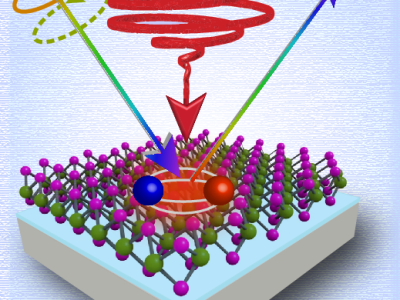
A team of researchers, including Dr. Artur Slobodeniuk who performed the theoretical calculations and led by Dr. Martin Kozák from Department of Chemical Physics and Optics, have published a groundbreaking paper on the manipulation of excitons in WSe2 and MoS2 monolayers in the journal npj 2D Materials and Applications. The work demonstrates that the irradiation of the transition metal dichalcogenide monolayers by strong infrared laser pulses can lift the valley degeneracy of exciton states in these materials. This phenomenon exists only during the application of the pump pulse -- tens of femtoseconds (in the current study), and disappears immediately when the pump pulse switches off. These findings open the door for ultrafast valleytronics operating at multiterahertz frequencies.
Excitons are quasiparticles that consist of an electron and a hole bound together by Coulomb interaction. In some semiconductors, the electrons/holes can have the same energies but different momenta. For this case, they say that such quasiparticles belong to different valleys. According to the quantum laws, the bound electron-hole pairs from different valleys should have the same energy, i.e., the excitonic states become degenerate by a valley. The transition metal dichalcogenide monolayers possess two non-equivalent valleys, and hence the excitons in such systems are doubly degenerated. Therefore such excitonic doublet state can be considered as a two-level system or qubit. The manipulation of the energies of this two-level system is an important element in potential opto-electronic applications of the studied materials.
The work represents a significant advance in the field of exciton manipulation. Our findings provide a possible way for the development of new and improved optoelectronic devices.
In the context of the study, the researchers used ultrafast laser pulses to manipulate the excitons energies in the transition metal dichalcogenide monolayers. By applying a strong non-resonant circularly polarized light, they induced separately the energy shifts of the excitons in one (so-called Stark shift), and in the opposite (so-called Bloch-Siegert shift) valleys. This selective manipulation of the exciton energy levels has significant implications for the development of ultrafast valleytronics, which can operate at very high frequencies and could lead to new types of electronic devices with increased speed and efficiency.
The researchers' approach is particularly promising because it does not rely on the use of expensive and cumbersome instruments to generate and manipulate the valley degrees freedom of the excitons in transition metal dichalcogenide monolayers. They use scalable compact laser-based devices, instead. It is expected that this research will spark further investigations into the properties and behavior of excitons in other 2D materials, leading to new breakthroughs in the field of optoelectronics.




